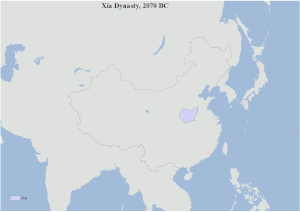
Back Chinese Keiserryk Afrikaans Kaiserreich China ALS Imperiu chinu AST চীনা সাম্রাজ্য Bengali/Bangla Imperi xinès Catalan Čínské císařství Czech Kaiserreich China German Imperio chino Spanish Chine impériale French Keizerryk Sina Frisian
This article has multiple issues. Please help improve it or discuss these issues on the talk page. (Learn how and when to remove these template messages)
|
Chinese Empire
| |||||
|---|---|---|---|---|---|
| c. 221 BC–1912 | |||||
| Motto: None | |||||
Anthem:
| |||||
 Approximate territorial extent of the various dynasties and states in Chinese history. | |||||
| Status | Empire | ||||
| Capital | |||||
| Official languages | Chinese | ||||
| Common languages | |||||
| Religion | |||||
| Demonym(s) | Chinese | ||||
| Government | Absolute monarchy | ||||
| Emperor aka Son of Heaven | |||||
• c. 221–210 BC (first) | Qin Shi Huang | ||||
• 1908–1912 (last) | Xuantong | ||||
| Chancellor | |||||
• 221–208 BC (first) | Li Si | ||||
• 1911–1912 (last) | Yikuang | ||||
| Legislature | Imperial Court | ||||
| History | |||||
| 230–221 BC | |||||
| 206–202 BC | |||||
| 581–618 | |||||
| 613–628 | |||||
| 1205–1279 | |||||
| 1368–1644 | |||||
| 1618–1683 | |||||
| 12 February 1912 | |||||
| Area | |||||
| All combined c.[1][2][3] | 15,000,000–15,500,000 km2 (5,800,000–6,000,000 sq mi) | ||||
| Population | |||||
• 1850 | 430,000,000 | ||||
| Currency | Ban Liang, Wu Zhu, Cash, Jiaochao, Tael, Paper money | ||||
| |||||
| Part of a series on the |
| History of China |
|---|
The Chinese Empire, also known as Imperial China, Empire of China,[a] Celestial Empire, or simply China, was an imperial realm that spanned much of East, North, Central, South and Southeast Asia from the 3rd century BC to the 20th century.[4]
Originally emerged as a loose collection of various Han Chinese-speaking entities during the Warring States period, the Qin's wars of unification brought most of the Huaxia realm into one single dynasty, establishing Qin as the first imperial dynasty in 221 BC, the year where the Chinese Empire was first established.[5] The Chinese Empire would continue to expand even after the collapse of the Qin dynasty, with the Han dynasty established itself with unprecedented expansion in the north, south and west.[6] It would be the Tang dynasty four centuries later that China really achieved the golden age of its imperial realm, where China became the world's most powerful economic, political and military power, a status which China would hold until the 9th century, along with its territory spanned from Central Asia, Tibet, Mongolia to Northeast Asia and partial Southeast Asia until being put to bed by the An Lushan rebellion.[7][8][9][10] The Chinese Empire marked its revival under the Mongol-based Yuan dynasty, in which China managed to incorporate Tibet and Mongolia into its inner territory. The Qing dynasty, founded three centuries after the fall of Yuan, laid ground to most of China's modern border today with its expansion into the north, central, south and southeast Asia.[11][12]
Following the 1911 Revolution, the Qing monarchy was abolished a year later, thus put an end to the centuries-old Chinese Empire following the imperial decree issuing abdication of the Xuantong Emperor.[13] Yuan Shikai attempted to restore the Chinese Empire three years later, with himself as the Emperor, but it was put to bed by the lack of popular support for the restoration of the monarchy.[citation needed]
- ^ Taagepera, Rein (1979). "Size and Duration of Empires: Growth-Decline Curves, 600 B.C. to 600 A.D". Social Science History. 3 (3/4): 121. doi:10.2307/1170959. JSTOR 1170959.
- ^ Taagepera, Rein (September 1997). "Expansion and Contraction Patterns of Large Polities: Context for Russia" (PDF). International Studies Quarterly. 41 (3): 499. doi:10.1111/0020-8833.00053. JSTOR 2600793.
- ^ Turchin, Adams & Hall (2006), p. 222
- ^ The Rise of the Chinese Empire.
- ^ "Qin Shi Huang | Biography, Accomplishments, Family, United China, Tomb, & Facts | Britannica". 8 April 2024.
- ^ Cite error: The named reference
hanexpansionwas invoked but never defined (see the help page). - ^ https://www.ushistory.org/civ/9d.asp
- ^ Pan, Yihong (1997). "Son of Heaven and Heavenly Qaghan: Sui-Tang China and its Neighbors". East Asian Studies Press. Studies on East Asia, Volume 20. Center for East Asian Studies, Western Washington University. doi:10.25710/vs3m-gw59.
- ^ "Northeast Asian History Network".
- ^ "Sinification of East and Southeast Asia".
- ^ "Overview and expansion of the Qing dynasty - the Qing dynasty - KS3 History - homework help for year 7, 8 and 9".
- ^ "Qing dynasty (1644–1911)".
- ^ "The abdication decree of Emperor Puyi (1912)". 4 June 2013.
Cite error: There are <ref group=lower-alpha> tags or {{efn}} templates on this page, but the references will not show without a {{reflist|group=lower-alpha}} template or {{notelist}} template (see the help page).
© MMXXIII Rich X Search. We shall prevail. All rights reserved. Rich X Search

